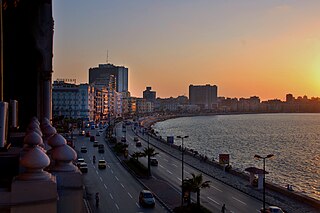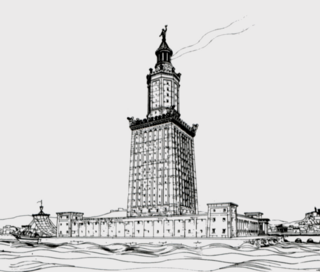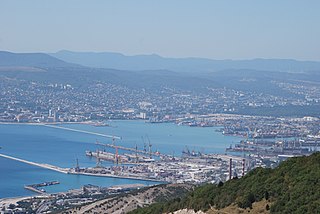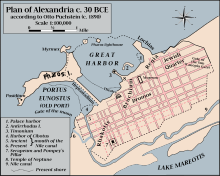
Alexandria is the second largest city in Egypt, and the largest city on the Mediterranean coast. Founded in c. 331 BC by Alexander the Great, Alexandria grew rapidly and became a major centre of Hellenic civilisation, eventually replacing Memphis, in present-day Greater Cairo, as Egypt's capital. During the Hellenistic period, it was home to the Lighthouse of Alexandria, which ranked among the Seven Wonders of the Ancient World, as well as the storied Library of Alexandria. Today, the library is reincarnated in the disc-shaped, ultramodern Bibliotheca Alexandrina. Its 15th-century seafront Qaitbay Citadel is now a museum. Called the "Bride of the Mediterranean" by locals, Alexandria is a popular tourist destination and an important industrial centre due to its natural gas and oil pipelines from Suez.

Transport in Egypt is centered in Cairo and largely follows the pattern of settlement along the Nile. The Ministry of Transportation and other government bodies are responsible for transportation in Egypt, whether by sea, river, land or air.

The Lighthouse of Alexandria, sometimes called the Pharos of Alexandria, was a lighthouse built by the Ptolemaic Kingdom of Ancient Egypt, during the reign of Ptolemy II Philadelphus. It has been estimated to have been at least 100 metres (330 ft) in overall height. One of the Seven Wonders of the Ancient World, for many centuries it was one of the tallest man-made structures in the world.

The Suez Canal is an artificial sea-level waterway in Egypt, connecting the Mediterranean Sea to the Red Sea through the Isthmus of Suez and dividing Africa and Asia. The 193.30 km (120.11 mi) long canal is a popular trade route between Europe and Asia.
Year 332 BC was a year of the pre-Julian Roman calendar. At the time, it was known as the Year of the Consulship of Calvinus and Arvina. The denomination 332 BC for this year has been used since the early medieval period, when the Anno Domini calendar era became the prevalent method in Europe for naming years.

A port is a maritime facility comprising one or more wharves or loading areas, where ships load and discharge cargo and passengers. Although usually situated on a sea coast or estuary, ports can also be found far inland, such as Hamburg, Manchester and Duluth; these access the sea via rivers or canals. Because of their roles as ports of entry for immigrants as well as soldiers in wartime, many port cities have experienced dramatic multi-ethnic and multicultural changes throughout their histories.

Lake Mariout, is a brackish lake in northern Egypt near the city of Alexandria. The lake area covered 200 square kilometres (77 sq mi) and had a navigable canal at the beginning of the 20th century, but at the beginning of the 21st century, it covers only about 50 square kilometres (19 sq mi).
The Port of London is that part of the River Thames in England lying between Teddington Lock and the defined boundary with the North Sea and including any associated docks. Once the largest port in the world, it was the United Kingdom's largest port as of 2020. Usage is largely governed by the Port of London Authority ("PLA"), a public trust established in 1908; while mainly responsible for coordination and enforcement of activities it also has some minor operations of its own.

Alexandria Governorate is one of the governorates of Egypt. The city of Alexandria was historically the capital of Egypt until the foundation of Fustat, which was later absorbed into Cairo. Today the Alexandria governorate is considered second in importance after the Cairo Governorate. It is located in the northern part of the country, directly on the Mediterranean Sea, making it one of the most important harbours in Egypt.

The Port of Hong Kong, located by the South China Sea, is a deepwater seaport dominated by trade in containerised manufactured products, and to a lesser extent raw materials and passengers. A key factor in the economic development of Hong Kong, the natural shelter and deep waters of Victoria Harbour provide ideal conditions for berthing and the handling of all types of vessels. It is one of the busiest ports in the world, in the three categories of shipping movements, cargo handled and passengers carried. This makes Hong Kong a Large-Port Metropolis.

Berenice Troglodytica, also called Berenike or Baranis, is an ancient seaport of Egypt on the western shore of the Red Sea. It is situated about 825 km south of Suez, 260 km east of Aswan in Upper Egypt and 140 km south of Marsa Alam. It was founded in 275 BCE by Ptolemy II Philadelphus (285–246 BCE), who named it after his mother, Berenice I of Egypt.

The Port of Karachi is one of South Asia's largest and busiest deep-water seaports, handling about 60% of the nation's cargo located in Karachi, Pakistan. It is located on the Karachi Harbour, between Kiamari azra langri, Manora, and Kakapir, and close to Karachi's main business district and several industrial areas. The geographic position of the port places it in close proximity to major shipping routes such as the Strait of Hormuz. The administration of the port is carried out by the Karachi Port Trust, which was established in 1857.
Rhacotis was the name for a city on the northern coast of Egypt at the site of Alexandria. Classical sources from the Greco-Roman era in both Ancient Greek and the Egyptian language suggest Rhacotis as an older name for Alexandria before the arrival of Alexander the Great.

The Port of Ashdod is one of Israel's three main cargo ports. The port is located in Ashdod, about 40 kilometers south of Tel Aviv, adjoining the mouth of the Lachish River. Its establishment significantly enhanced the country's port capacity. It handles the largest volume of cargo containers annually of all Israeli ports. Ships carrying humanitarian aid for the Gaza Strip also unload their cargo at Ashdod.

The Heptastadion was a giant causeway, often referred to as a mole or a dyke built by the people of Alexandria, Egypt in the 3rd century BC during the Ptolemaic period. The Heptastadion was created to link Pharos Island to the mainland coast and given a name based on its length. Overall it was more than three-quarters of a mile long.

The history of Alexandria dates back to the city's founding, by Alexander the Great, in 331 BC. Yet, before that, there were some big port cities just east of Alexandria, at the western edge of what is now Abu Qir Bay. The Canopic (westernmost) branch of the Nile Delta still existed at that time, and was widely used for shipping.

The Port of Latakia is a seaport located on the Mediterranean sea in the city of Latakia. Established on 12 February 1950, it has since served as Syria's main seaport.

Novorossiysk Sea Port is one of the largest ports in the Black Sea basin and the largest in Krasnodar Krai. At 8.3 km, the NSP berthing line is the longest among all the ports of Russia. The port is located on the Northeast coast of the Black Sea, in the Tsemes Bay. The bay is ice-free and open for navigation all year round. However, in winter the navigation occasionally stops due to the hazardous northeastern bora wind. The Tsemes Bay allows deep-draft vessels up to 19 m DWT, the inner harbour — up to 12.5 m. The liquid bulk terminals depth range from 8.4 to 15.6 m, suitable for tankers with a deadweight of up to 250,000 tons, like Suezmax-class vessels.

Antirhodos was an island in the eastern harbor of Alexandria, Egypt, on which a Ptolemaic Egyptian palace was sited. The island was occupied until the reigns of Septimius Severus and Caracalla and it probably sank in the 4th century, when it succumbed to earthquakes and a tsunami following an earthquake in the eastern Mediterranean near Crete in the year 365. The site now lies underwater, near the seafront of modern Alexandria, at a depth of approximately five metres (16 ft).

Cura Annonae was the term used in Imperial Rome, in honour of the goddess Annona, to describe the import and distribution of grain to the residents of the cities of Rome and, after its foundation, Constantinople. The city of Rome imported all the grain consumed by its population, estimated to number 1,000,000 by the 2nd century AD. This included recipients of the grain dole or corn dole, a government program which gave out subsidized grain, then free grain, and later bread, to about 200,000 of Rome's adult male citizens. Rome's grain subsidies were originally ad hoc emergency measures taken to import cheap grain from trading partners and allies at times of scarcity, to help feed growing numbers of indebted and dispossessed citizen-farmers. By the end of the Republic, both grain subsidies and grain doles had become permanent, uniquely Roman institutions. The grain dole was reluctantly adopted by Augustus and later emperors as a free monthly issue to those who qualified to receive it.
















